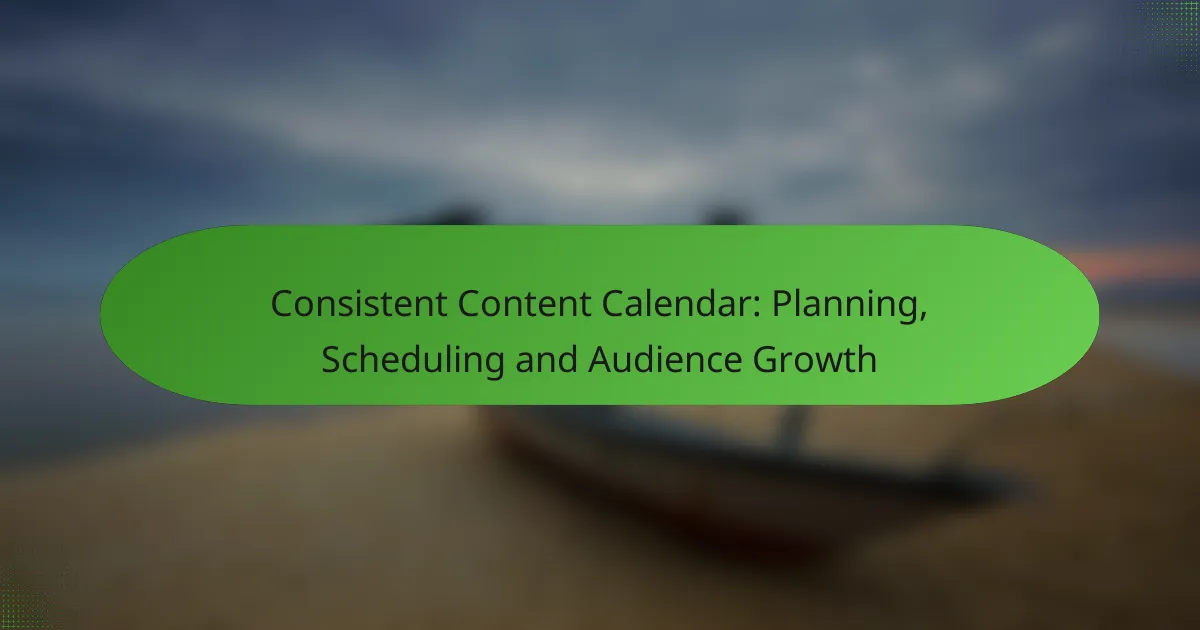Creating a consistent content calendar is essential for enhancing audience engagement and driving growth. By strategically planning and scheduling your content, you can maintain regularity and align with your marketing goals while catering to your audience’s preferences. Utilizing the right tools can streamline this process, ensuring that you deliver valuable and engaging material consistently.

How to Create a Consistent Content Calendar?
Creating a consistent content calendar involves planning and scheduling your content strategically to enhance audience engagement and growth. A well-structured calendar helps maintain regularity, align with marketing goals, and cater to your target audience’s preferences.
Define content goals
Start by outlining clear content goals that align with your overall marketing strategy. These goals could include increasing brand awareness, generating leads, or boosting engagement on social media platforms.
Consider using the SMART criteria—specific, measurable, achievable, relevant, and time-bound—to refine your goals. For example, aim to increase website traffic by 20% over the next quarter through targeted blog posts and social media updates.
Identify target audience
Understanding your target audience is crucial for creating relevant content. Identify demographics such as age, gender, location, and interests to tailor your messaging effectively.
Utilize tools like surveys or social media analytics to gather insights about your audience’s preferences and behaviors. This information will guide your content creation and help you resonate with your audience.
Select content themes
Choosing content themes provides a cohesive direction for your calendar. These themes should reflect your audience’s interests and align with your content goals.
Consider seasonal trends, industry news, or common pain points your audience faces. For instance, if your audience is primarily small business owners, themes could include entrepreneurship tips, marketing strategies, or financial management.
Establish a publishing frequency
Decide how often you will publish content based on your resources and audience expectations. Consistency is key; whether it’s daily, weekly, or monthly, stick to a schedule that works for you.
For example, a weekly blog post combined with daily social media updates can create a balanced approach. Monitor engagement to adjust frequency as needed, ensuring you meet your audience’s demands without sacrificing quality.
Choose content formats
Selecting the right content formats is essential for engaging your audience. Consider various formats such as articles, videos, infographics, or podcasts to diversify your content offering.
Evaluate which formats resonate best with your audience. For instance, if your audience prefers visual content, focus on creating infographics or videos. A mix of formats can cater to different preferences and enhance overall engagement.

What Tools Can Help with Content Scheduling?
Several tools can streamline content scheduling, making it easier to plan and manage your content calendar effectively. These tools help organize tasks, set deadlines, and ensure that your audience receives consistent content.
Google Calendar
Google Calendar is a versatile tool for scheduling content due to its user-friendly interface and integration with other Google services. You can create multiple calendars for different content types, set reminders, and share calendars with team members to enhance collaboration.
Consider color-coding your events to differentiate between content types, such as blog posts, social media updates, and newsletters. This visual organization helps you quickly assess your content schedule at a glance.
Trello
Trello is a project management tool that uses boards, lists, and cards to help you visualize your content workflow. You can create a board specifically for your content calendar, adding cards for each piece of content and moving them through stages like “Ideas,” “In Progress,” and “Published.”
Utilize Trello’s checklist feature to outline steps for each content piece, ensuring you don’t miss any critical tasks. You can also assign due dates and team members to keep everyone accountable.
Asana
Asana is another powerful project management tool that allows for detailed task management and scheduling. You can create projects for different content campaigns and assign tasks with specific deadlines to team members.
Asana’s timeline view is particularly useful for visualizing your content schedule over weeks or months. This helps in identifying potential bottlenecks and adjusting deadlines as needed to maintain a steady flow of content.
CoSchedule
CoSchedule is designed specifically for marketers and content creators, offering a comprehensive solution for content scheduling and promotion. It integrates with various platforms, allowing you to manage your blog posts, social media, and email campaigns from one place.
One of CoSchedule’s standout features is its marketing calendar, which provides a clear overview of all your scheduled content. This helps in aligning your content strategy with marketing goals and ensures that your messaging is consistent across channels.

How to Optimize Content for Audience Growth?
To optimize content for audience growth, focus on creating valuable, relevant, and engaging material that resonates with your target audience. Implementing effective strategies such as SEO best practices, engaging with audience feedback, and leveraging social media can significantly enhance your reach and impact.
Utilize SEO best practices
Applying SEO best practices is crucial for increasing your content’s visibility in search engines. Start by conducting keyword research to identify terms your audience is searching for, and incorporate these keywords naturally into your content. Aim for a keyword density of around 1-2% to maintain readability while optimizing for search.
Additionally, ensure your content is structured with proper headings, meta descriptions, and alt tags for images. This not only helps search engines understand your content but also improves user experience. Regularly updating your content can also boost its relevance and ranking over time.
Engage with audience feedback
Engaging with audience feedback is essential for refining your content strategy. Monitor comments, social media interactions, and surveys to gather insights on what your audience values. This feedback can guide your content creation, ensuring it aligns with their interests and needs.
Consider implementing a feedback loop by encouraging your audience to share their thoughts on specific topics or formats. This can be done through polls or direct questions in your content. Responding to feedback not only builds community but also fosters loyalty among your audience.
Leverage social media platforms
Leveraging social media platforms is an effective way to amplify your content’s reach. Share your content across various channels like Facebook, Twitter, and LinkedIn, tailoring your message to fit the platform’s audience. Use engaging visuals and compelling headlines to capture attention and encourage shares.
Additionally, consider using paid advertising options on these platforms to target specific demographics. This can help you reach a wider audience and drive traffic back to your content. Regularly analyze engagement metrics to refine your strategy and focus on the platforms that yield the best results.

What Are the Key Metrics for Measuring Success?
Key metrics for measuring success in content marketing include traffic growth, engagement rates, and conversion rates. These metrics provide insights into how well your content resonates with your audience and its effectiveness in achieving business goals.
Traffic growth
Traffic growth refers to the increase in the number of visitors to your website over a specific period. Monitoring this metric helps you understand the reach of your content and its appeal to your target audience. Aim for a steady growth rate, typically between 10-30% over several months, depending on your industry.
To enhance traffic growth, consider optimizing your content for search engines (SEO), promoting it through social media, and leveraging email marketing. Regularly analyze traffic sources to identify which channels are most effective.
Engagement rates
Engagement rates measure how actively your audience interacts with your content, often reflected through metrics like comments, shares, and time spent on the page. High engagement indicates that your content resonates well with readers. A good engagement rate typically falls between 1-5% for social media posts and can vary for blog content.
To boost engagement, create compelling headlines, use visuals, and encourage user interaction through questions or calls to action. Monitor which types of content generate the most engagement to refine your strategy.
Conversion rates
Conversion rates track the percentage of visitors who take a desired action, such as signing up for a newsletter or making a purchase. This metric is crucial for assessing the effectiveness of your content in driving business results. A typical conversion rate ranges from 2-5%, but this can vary widely by industry and type of offer.
To improve conversion rates, ensure your content includes clear calls to action, optimize landing pages for user experience, and test different approaches through A/B testing. Regularly review your conversion funnel to identify and address any drop-off points.
